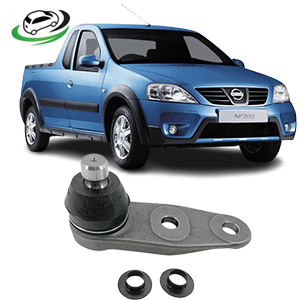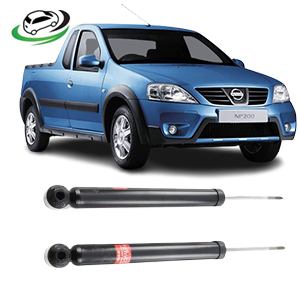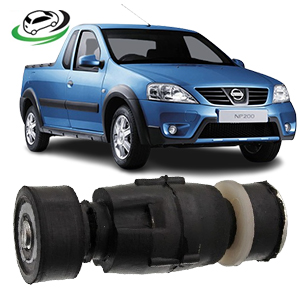-13%
Get Nissan Pick Up NP200 Rod Assy-Connecting, Front Stabilizer Link 54616-00Q0G
The Rod Assembly-Connecting, Front Stabilizer Link, commonly referred to as the front stabilizer link or sway bar link, is an essential component of a vehicle’s suspension system. It connects the sway bar (stabilizer bar) to the suspension’s control arms or struts, helping to reduce body roll and improve stability, especially during cornering or when driving over uneven surfaces. The stabilizer link plays a critical role in enhancing handling, maintaining comfort, and ensuring vehicle safety.
In this detailed explanation, we’ll explore the structure, function, types, benefits, maintenance, and symptoms of failure for the front stabilizer link in 1000 words.
Structure of the Front Stabilizer Link
The front stabilizer link is a simple yet effective component designed to connect the sway bar to the suspension, allowing for coordinated movement of the left and right wheels during turns. A typical stabilizer link consists of the following parts:
- Rod: The rod is the main connecting piece of the stabilizer link. It is often made from high-strength steel or aluminum to withstand the forces exerted during driving. The rod’s length can vary depending on the vehicle’s suspension design.
- Ball Joints or Bushings: At either end of the rod, there are usually ball joints or bushings that attach to the sway bar and control arms or struts. Ball joints allow for smooth pivoting movement, while bushings provide some flexibility and vibration dampening. These components are often enclosed in rubber boots or surrounded by polyurethane bushings to protect against dirt, moisture, and other contaminants.
- Mounting Hardware: The stabilizer link is secured in place with mounting hardware, which typically includes nuts, bolts, and washers. These components ensure a firm connection between the sway bar and the suspension.
- Protective Boots: Many stabilizer links are equipped with rubber boots to protect the ball joints from dirt, water, and other debris, extending their lifespan by preventing premature wear.
Function of the Front Stabilizer Link
The front stabilizer link connects the stabilizer bar to the suspension, ensuring that the bar can function effectively. The stabilizer bar itself is a U-shaped or torsion bar that runs across the front or rear of the vehicle and helps to minimize body roll during cornering. The stabilizer link’s job is to transmit the forces from the suspension to the stabilizer bar, allowing it to twist and balance the load between the left and right wheels.
Key functions of the front stabilizer link include:
- Reduction of Body Roll: The main purpose of the stabilizer link is to reduce body roll when the vehicle is cornering. When a vehicle enters a turn, the body tends to lean outward due to centrifugal force. The stabilizer link ensures that the sway bar transfers some of the force from one side of the vehicle to the other, keeping the body more level and improving cornering stability.
- Improved Handling and Stability: By reducing body roll, the stabilizer link enhances the vehicle’s handling and overall stability. This is especially important for vehicles that take sharp turns or navigate uneven roads, as the link helps maintain consistent tire contact with the road surface, ensuring better control and traction.
- Even Load Distribution: The stabilizer link helps distribute the load more evenly between the left and right wheels during cornering, preventing excessive pressure on one side of the suspension. This not only improves vehicle handling but also extends the life of other suspension components like the control arms, shocks, and tires.
- Minimization of Suspension Movement: The stabilizer link works to reduce excessive movement of the suspension system, which can result in a smoother ride. By limiting sway and excessive vertical movement, the stabilizer link helps maintain better ride comfort.
Types of Front Stabilizer Links
There are different types of stabilizer links depending on the vehicle’s suspension design and performance requirements:
- Standard Stabilizer Links: These are the most common types of stabilizer links found in everyday vehicles. They are typically made of steel and include rubber bushings or ball joints to provide a balance of durability and comfort.
- Adjustable Stabilizer Links: Adjustable stabilizer links are often used in performance or modified vehicles. They allow for fine-tuning of the suspension geometry, which can enhance handling for track racing or off-road driving. These links typically have threaded rods that can be lengthened or shortened to adjust the sway bar’s effectiveness.
- Heavy-Duty Stabilizer Links: For larger vehicles like trucks, SUVs, or vehicles used for off-road driving, heavy-duty stabilizer links are necessary. These are made from reinforced materials like steel or aluminum alloys and feature stronger bushings to withstand the extra stress and forces placed on the suspension during heavy-duty use.
- Performance Stabilizer Links: Performance links are often used in sports cars or vehicles that prioritize handling. They may be made from lightweight, high-strength materials like carbon fiber or aluminum and may incorporate polyurethane bushings for greater stiffness and improved responsiveness.
Importance of the Front Stabilizer Link in Vehicle Performance
The front stabilizer link plays a crucial role in maintaining vehicle performance, especially in terms of handling and safety. Here’s why the stabilizer link is so important:
- Enhanced Cornering Stability: Without a functioning stabilizer link, the vehicle’s body would roll excessively during turns, leading to a loss of control. The stabilizer link ensures that the vehicle remains level, improving cornering stability and allowing the driver to navigate turns more safely.
- Better Traction: By reducing body roll, the stabilizer link ensures that all four tires maintain better contact with the road surface, leading to improved traction. This is particularly important during high-speed cornering or emergency maneuvers.
- Improved Safety: Excessive body roll can make the vehicle feel unstable and harder to control, especially during sudden lane changes or while driving on winding roads. A functioning stabilizer link helps mitigate these risks, providing a safer driving experience.
- Increased Comfort: The stabilizer link helps smooth out the ride by reducing excessive suspension movement. Without it, the vehicle might sway or feel unstable, leading to a less comfortable ride, especially on rough or uneven roads.
Maintenance of the Front Stabilizer Link
Proper maintenance of the front stabilizer link is essential for ensuring the longevity of the suspension system and maintaining vehicle safety and comfort. Here are key maintenance tips:
- Regular Inspection: Stabilizer links should be inspected during routine vehicle maintenance or when experiencing suspension issues. Look for signs of wear, such as cracked or torn rubber boots, loose connections, or rust on the rod.
- Lubrication (if applicable): Some stabilizer links come with grease fittings that allow for periodic lubrication of the ball joints. Keeping the joints lubricated helps prevent wear and reduces friction, prolonging the life of the link.
- Replacement of Worn Links: Stabilizer links should be replaced if they show signs of wear, such as excessive play in the ball joints or if the rubber boots are damaged. A worn stabilizer link can lead to handling problems and reduced stability.
- Check for Alignment Issues: When replacing stabilizer links, it’s essential to ensure that the suspension remains properly aligned. Misalignment can lead to uneven tire wear and additional stress on suspension components.
Symptoms of a Failing Front Stabilizer Link
As stabilizer links wear out, they can cause several noticeable symptoms:
- Clunking or Knocking Noise: A common sign of a failing stabilizer link is a clunking or knocking noise when driving over bumps or during turns. This happens when the ball joint or bushings wear out, allowing excessive movement.
- Excessive Body Roll: If the stabilizer link is worn or broken, the vehicle may exhibit excessive body roll during cornering. This can make the vehicle feel unstable or difficult to control.
- Steering Instability: A worn stabilizer link can cause the steering to feel loose or imprecise. The driver may notice that the vehicle sways or wanders during turns or when driving on uneven roads.
- Uneven Tire Wear: A failing stabilizer link can lead to improper suspension alignment, causing uneven tire wear. This can reduce the life of the tires and negatively impact handling.
Conclusion
The Rod Assembly-Connecting, Front Stabilizer Link is a vital part of a vehicle’s suspension system, designed to improve handling, reduce body roll, and provide stability during cornering. It connects the sway bar to the suspension, allowing the wheels to work in harmony while minimizing movement during turns. Proper maintenance, such as regular inspections, lubrication, and timely replacement, can ensure the longevity of the stabilizer link and contribute to a safer, more comfortable driving experience. Recognizing the signs of a failing stabilizer link, such as clunking noises, excessive body roll, and steering instability, is crucial for maintaining optimal vehicle performance.
Follow us on Facebook for more parts.



